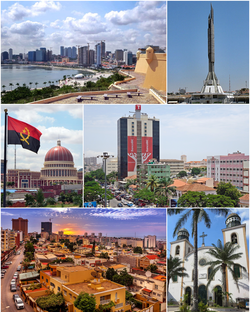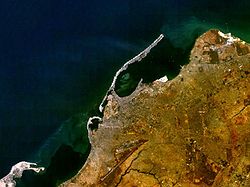Luanda
Luanda is the capital and the largest city of Angola. Its former name was Loanda. It is a main seaport of the country on the Atlantic Ocean. In 1995, about 3 million people lived there.
City | |
 | |
| Coordinates: 8°50′18″S 13°14′4″E / 8.83833°S 13.23444°E | |
| Country | |
| Province | Luanda |
| Founded | 1576 |
| Area | |
| • City | 116 km2 (45 sq mi) |
| • Metro | 1,876 km2 (724 sq mi) |
| Elevation | 6 m (20 ft) |
| Population (2019)[2] | |
| • City | 2,571,861 [1] |
| • Metro | 8,069,612 |
| • Metro density | 4,301.5/km2 (11,140.8/sq mi) |
| 2019 | |
| Time zone | +1 |
| Climate | BSh |
It is a center of manufacturing, but very destroyed because of a long civil war.
It was founded by Portuguese in 1575 as São Paulo de Luanda and has been the administrative center of Angola since 1627 (except for 1640–1648). When Angola got independence in 1975, it became the capital of Angola.
Luanda Media
São Miguel Fortress, founded in 1576 by Paulo Dias de Novais, today hosts the Armed Forces Museum.
Portuguese Armed Forces marching in Luanda during the Portuguese Colonial Wars (1961–74).
President José Eduardo dos Santos with President of Brazil Dilma Rousseff at the Presidential Palace in 2011.
Satellite view of the City of Luanda and the Ilha de Luanda.
Beach cabanas on Ilha de Luanda
References
- ↑ Instituto Nacional de Estatística, República de Angola.
- ↑ "Angola: Administrative Division (Provinces and Municipalities) - Population Statistics, Charts and Map". Archived from the original on 2018-02-12. Retrieved 2018-02-12. Citypopulation reporting on Instituto Nacional de Estatística, República de Angola (web) projection july 2019









